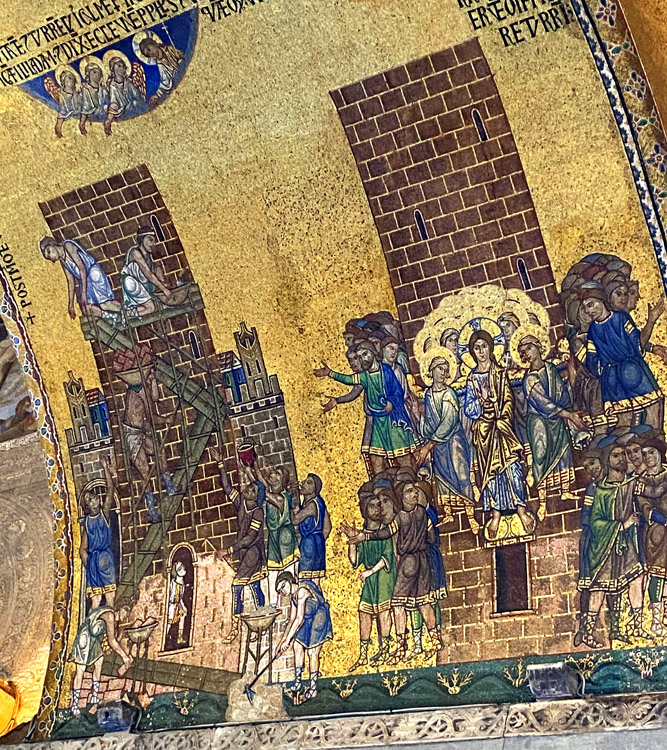
The Tower of Babel
13th century
Mosaic
St. Mark's Basilica
West wall of the North section of the narthex
The inscription at the top and sides is from Genesis 11:4-8, in which the "sons of Adam" resolve to "make a city for ourselves and a tower" and in response God makes them all speak different languages so that they cannot complete their work. As in the other Genesis mosaics in St. Mark's, God is pictured as Christ – youthful and carrying a scepter topped by a cross.
Unlike the contemporary mosaics on this subject in Palermo and in Monreale, San Marco's treatment pairs a scene of the building of the tower with a second tower presided over by the enthroned Christ, his angels, and a multitude of men in short tunics. I would suggest that the second tower represents the original unity of language which was lost through the building of the Babel tower. In Genesis 11:1-2 "the earth was of one tongue, and of the same speech. And when they migrated from the east, they found a plain in the land of Sennaar, and dwelt in it." Commenting on the "allegorical" level of meaning in this passage, the Glossa Ordinaria says:
By "earth" is understood the Church Militant; by "speech," its true preaching and doctrine. In the beginning the Church had one language – preaching and teaching one God, one faith, one baptism, as is said in Ephesians 4. But some men withdrew themselves from the East (that is, from Christ: Zachariah 6, "Behold the man, East is his name"), and they built the tower of pride, from which followed the preaching of diverse heresies.1
The "East" that is Christ is represented in the mosaic by the tower on the right, and the tightly grouped angels and men standing with him represent the undivided Church.
Christ and his angels are pictured as if they were in a two-dimensional picture placed on the front of the tower, as if taken from a manuscript illumination with gold ground. This separate treatment may be a response to a comment by Eucherius of Lyon on verse 7, "Let us go down, and there confound their tongue…." Eucherius says, "God does not change place but is always and everywhere a totality, but 'go down' means he is doing something on earth."2
View this image in full resolution.
Read more about images from Genesis.
Photographed at St. Mark's Basilica by Richard Stracke, shared under Attribution-NonCommercial-ShareAlike license.